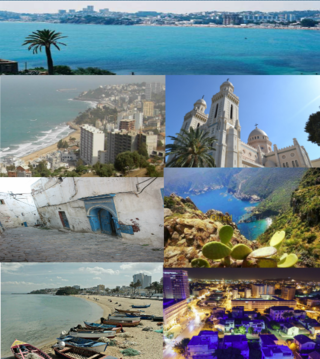
Hippo Regius is the ancient name of the modern city of Annaba, Algeria. It historically served as an important city for the Phoenicians, Berbers, Romans, and Vandals. Hippo was the capital city of the Vandal Kingdom from 435 to 439 AD. until it was shifted to Carthage following the Vandal capture of Carthage (439).

Annaba, formerly known as Bon, Bona and Bône, is a seaport city in the northeastern corner of Algeria, close to the border with Tunisia. Annaba is near the small Seybouse River and is in the Annaba Province. With a population of about 464,740 (2019) and 1,000,000 for the metropole, Annaba is the third-largest city and the leading industrial center in Algeria.

Cirta, also known by various other names in antiquity, was the ancient Berber and Roman settlement which later became Constantine, Algeria.

Guelma is the capital of Guelma Province and Guelma District, located in north-eastern Algeria, about 65 kilometers from the Mediterranean coast. Its location corresponds to that of ancient Calama.

Thagaste was a Roman-Berber city in present-day Algeria, now called Souk Ahras. The town was the birthplace of Saint Augustine.

Mila is a city in the northeast of Algeria and the capital of Mila Province. In antiquity, it was known as Milevum or Miraeon, Μιραίον and was situated in the Roman province of Numidia.

Souk Ahras is a municipality in Algeria. It is the capital of Souk Ahras Province. The Numidian city of Thagaste, on whose ruins Souk Ahras was built, was the birthplace of Augustine of Hippo and a center of Berber culture. It was a city of great culture, described as the very hub of civilization.

Bouchegouf is a town and district in Guelma Province, Algeria.

Tobna, also known by the ancient names of Tubunae or Thubunae, is a ruined former city in Batna Province of Algeria, located just south of the modern city of Barika. From this position, it once controlled the eastern part of the Hodna region, while M'Sila did the west. It flourished from the time of the Roman Empire through the Islamic Middle Ages, until it was sacked and destroyed by the Banu Hilal in the 11th century, after which it was finally abandoned.

Mauri was the Latin designation for the Berber population of Mauretania, located in the west side of North Africa on the shores of the Mediterranean Sea, Mauretania Tingitana and Mauretania Caesariensis, in present-day Morocco and northwestern Algeria.

Téboursouk is a town and commune in the Béja Governorate, Tunisia. It is located at 36° 27′ 26″N, 009° 14′ 54″E.

Madauros was a Roman-Berber city and a former diocese of the Catholic Church in the old state of Numidia, in present-day Algeria.

Calama was a colonia in the Roman province of Numidia situated where Guelma in Algeria now stands.

Thiava was an ancient Roman-Berber civitas in Numidia, Africa Proconsulare and in the Vandal Kingdom. It was a Latin Catholic diocese.

The Roman Africans or African Romans were the ancient populations of Roman North Africa that had a Romanized culture, some of whom spoke their own variety of Latin as a result. They existed from the Roman conquest until their language gradually faded out after the Arab conquest of North Africa in the Early Middle Ages.

Numidia was a Roman province on the North African coast, comprising roughly the territory of north-east Algeria.

The Diocese of Thagaste is an ancient and famous Titular See of the Roman Catholic Church.

The Vandal conquest of Roman Africa, also known as the Vandal conquest of North Africa was the conquest of Mauretania Tingitana, Mauretania Caesariensis, and Africa Proconsolaris by the migrating Vandals and Alans. The conflict lasted 13 years with a period of four years of peace, and led to the establishment of the Vandal Kingdom in 435.





















